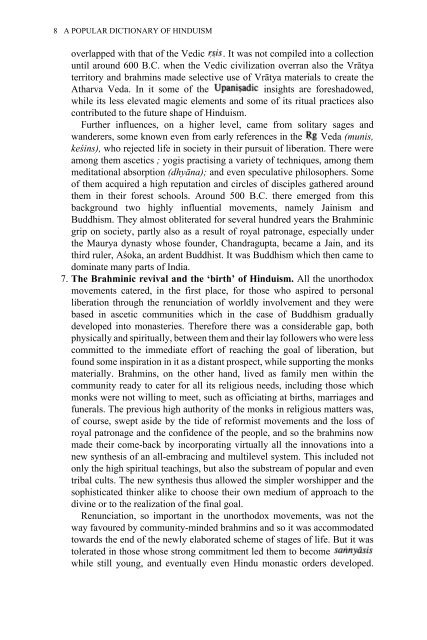Create successful ePaper yourself
Turn your PDF publications into a flip-book with our unique Google optimized e-Paper software.
8 A POPULAR DICTIONARY OF HINDUISM<br />
overlapped with that <strong>of</strong> the Vedic . It was not compiled into a collection<br />
until around 600 B.C. when the Vedic civilization overran also the Vrātya<br />
territory and brahmins made selective use <strong>of</strong> Vrātya materials to create the<br />
Atharva Veda. In it some <strong>of</strong> the<br />
insights are foreshadowed,<br />
while its less elevated magic elements and some <strong>of</strong> its ritual practices also<br />
contributed to the future shape <strong>of</strong> <strong>Hinduism</strong>.<br />
Further influences, on a higher level, came from solitary sages and<br />
wanderers, some known even from early references in the Veda (munis,<br />
keśins), who rejected life in society in their pursuit <strong>of</strong> liberation. There were<br />
among them ascetics ; yogis practising a variety <strong>of</strong> techniques, among them<br />
meditational absorption (dhyāna); and even speculative philosophers. Some<br />
<strong>of</strong> them acquired a high reputation and circles <strong>of</strong> disciples gathered around<br />
them in their forest schools. Around 500 B.C. there emerged from this<br />
background two highly influential movements, namely Jainism and<br />
Buddhism. They almost obliterated for several hundred years the Brahminic<br />
grip on society, partly also as a result <strong>of</strong> royal patronage, especially under<br />
the Maurya dynasty whose founder, Chandragupta, became a Jain, and its<br />
third ruler, Aśoka, an ardent Buddhist. It was Buddhism which then came to<br />
dominate many parts <strong>of</strong> India.<br />
7. The Brahminic revival and the ‘birth’ <strong>of</strong> <strong>Hinduism</strong>. All the unorthodox<br />
movements catered, in the first place, for those who aspired to personal<br />
liberation through the renunciation <strong>of</strong> worldly involvement and they were<br />
based in ascetic communities which in the case <strong>of</strong> Buddhism gradually<br />
developed into monasteries. Therefore there was a considerable gap, both<br />
physically and spiritually, between them and their lay followers who were less<br />
committed to the immediate effort <strong>of</strong> reaching the goal <strong>of</strong> liberation, but<br />
found some inspiration in it as a distant prospect, while supporting the monks<br />
materially. Brahmins, on the other hand, lived as family men within the<br />
community ready to cater for all its religious needs, including those which<br />
monks were not willing to meet, such as <strong>of</strong>ficiating at births, marriages and<br />
funerals. The previous high authority <strong>of</strong> the monks in religious matters was,<br />
<strong>of</strong> course, swept aside by the tide <strong>of</strong> reformist movements and the loss <strong>of</strong><br />
royal patronage and the confidence <strong>of</strong> the people, and so the brahmins now<br />
made their come-back by incorporating virtually all the innovations into a<br />
new synthesis <strong>of</strong> an all-embracing and multilevel system. This included not<br />
only the high spiritual teachings, but also the substream <strong>of</strong> popular and even<br />
tribal cults. The new synthesis thus allowed the simpler worshipper and the<br />
sophisticated thinker alike to choose their own medium <strong>of</strong> approach to the<br />
divine or to the realization <strong>of</strong> the final goal.<br />
Renunciation, so important in the unorthodox movements, was not the<br />
way favoured by community-minded brahmins and so it was accommodated<br />
towards the end <strong>of</strong> the newly elaborated scheme <strong>of</strong> stages <strong>of</strong> life. But it was<br />
tolerated in those whose strong commitment led them to become<br />
while still young, and eventually even Hindu monastic orders developed.


















